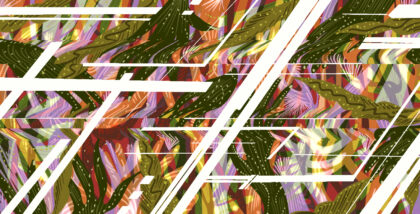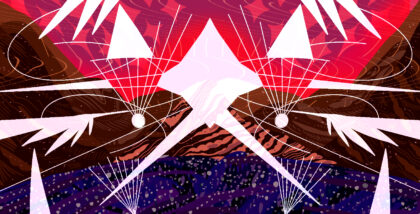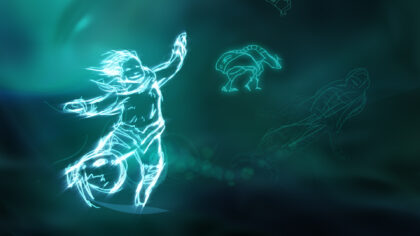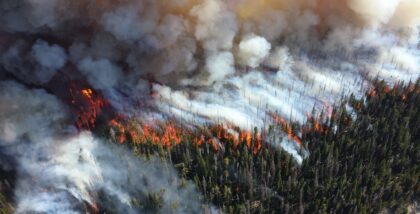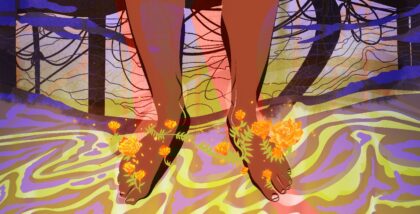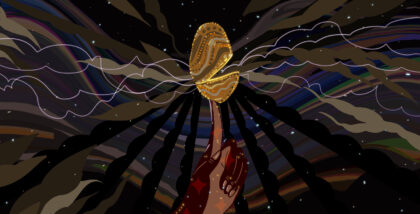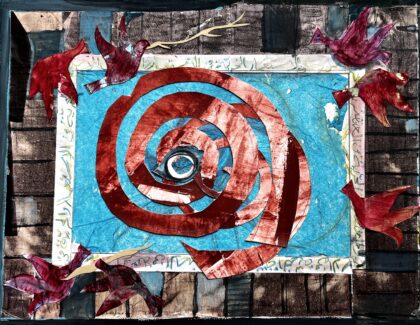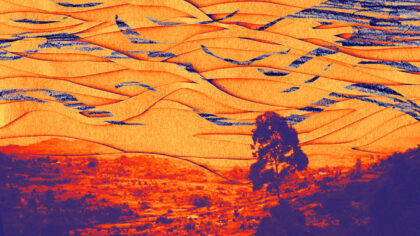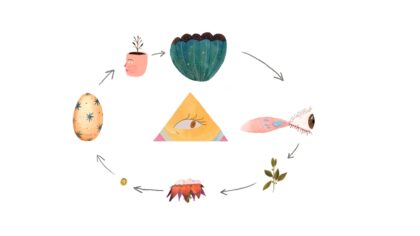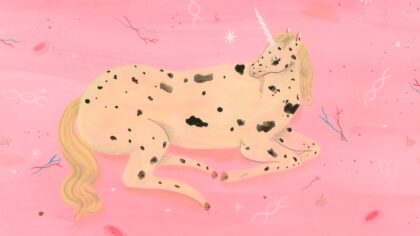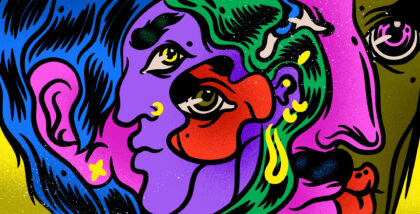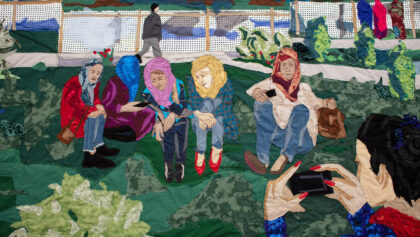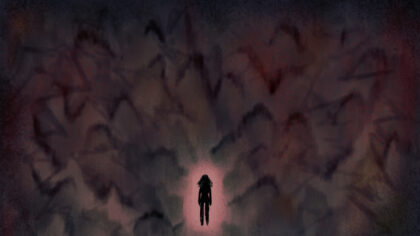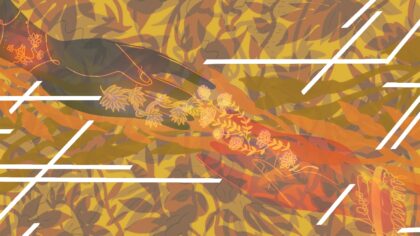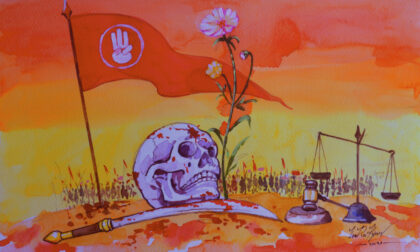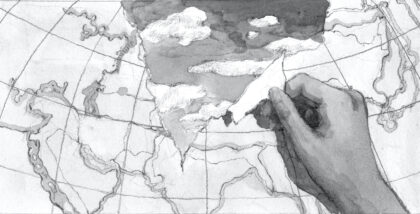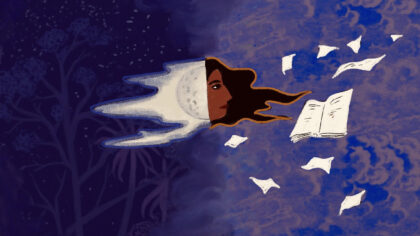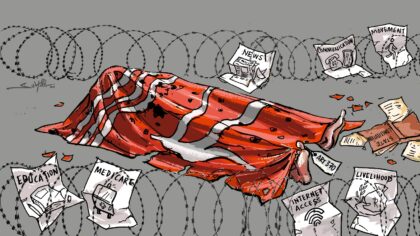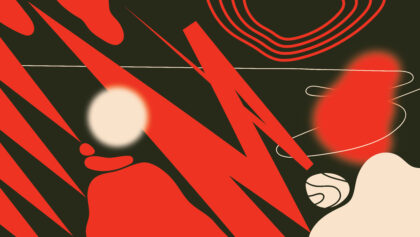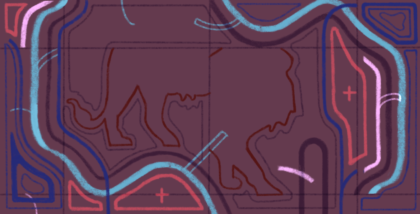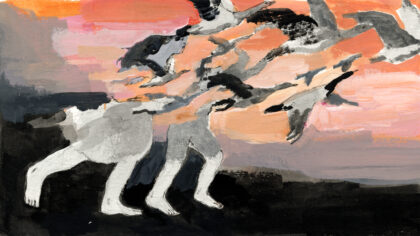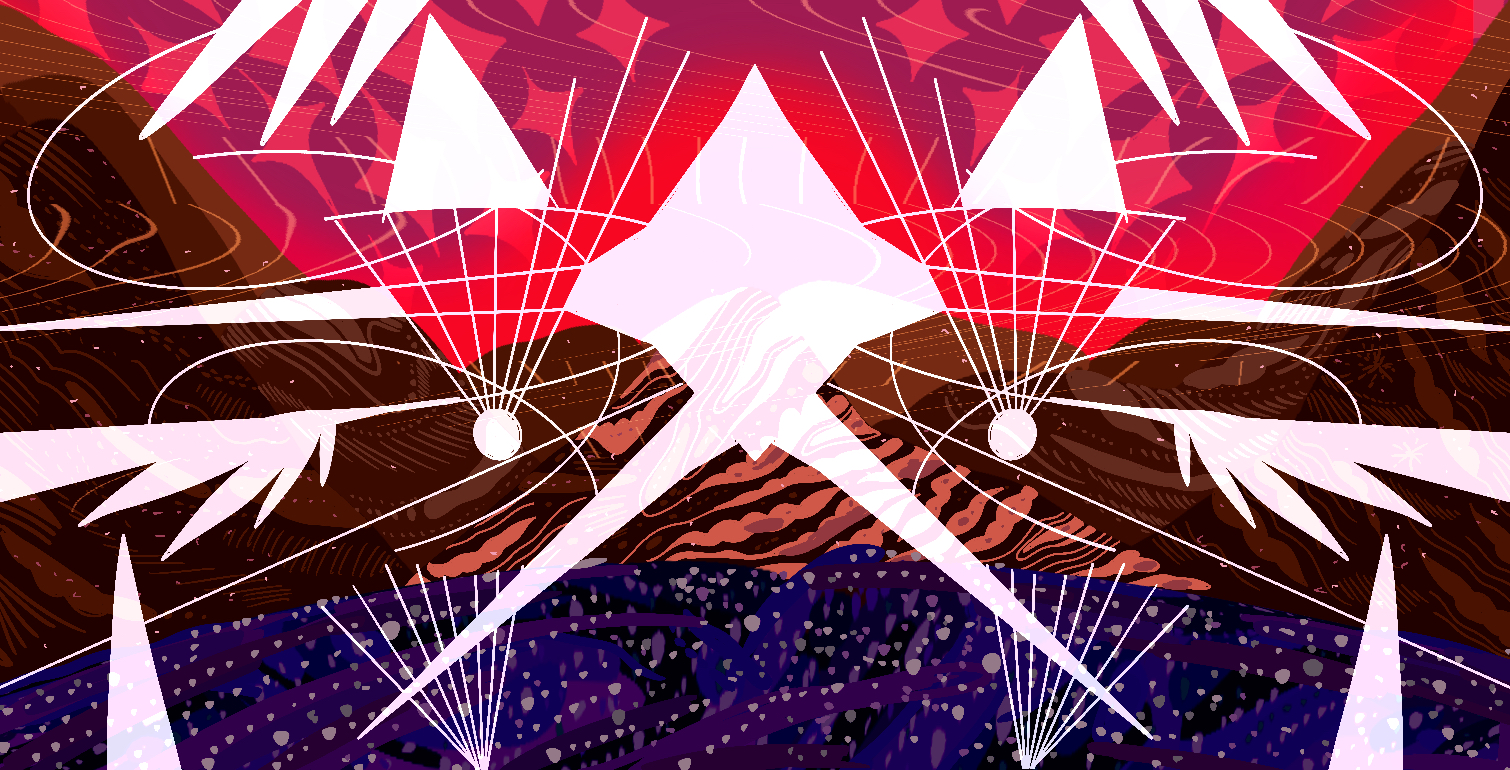 Art by Sab Meynert
Art by Sab Meynert
In 1683, in El Paso del Norte—the city we know today as Ciudad Juárez—a local leader named Juan Sabeata met with the Spanish colonial governor and listed for him the names of some of the people who lived among the calderas and high plains and mesas and arroyos of his part of the northern Chihuahuan Desert, in what now is the Big Bend region of southwest Texas. A Spanish scribe recorded the names in his ledger: The Nation That Grinds. The Nation of the Ugly Arrows. The People of the Ugly Water. The People Who Eat. The People of the Nut. The People of the Alligators. The People of Tanaque and of Toapa. The People called Tuxaxa, Penunde, Ti Jemu, Tohajo, Emiti, Geabori, Cocuma, Teanama, Obori, Ari Human, Ytaca, Tumpotoqua, Mana, and Quide. The People called Eat House, the People called Bean, the People called the Deaf Ones, the People Who Make Bows. The Borobamo Nation. The Great Kingdom of the Teyas or Caddo. The Very Widespread Nation of Qutas, and the Widespread Nation of Humanas, made up of thirty-six different nations. Sabeata himself was Jumano. Sabeata told the Spanish that there were, in his desert, many more nations that he did not name.
What was the purpose of Sabeata’s list? The archive tells us that Sabeata was a shrewd diplomat who had, in the words of the historian Nancy Parrot Hickerson, “mastered the conventions of Spanish officialdom,” and wanted to encourage the Spanish invasion of his desert because, in his projection, the better-armed conquistadors would protect Pueblo nations from their enemies the Apache. Perhaps he was trying to demonstrate to the colonizers the abundance of souls their missionaries could claim for conversion. Perhaps, like many people under occupation before and since, the world over, he gambled that forging an alliance with the colonizers would stave off destruction. But the conquistadors envisioned the desert mostly as a route to strata of silver and mineral and pasture. In coming years, to simplify things, they opted to ignore Sabeata’s catalog of his neighbors. The landscape of their imagining was devoid of human life, and their maps called his land El Despoblado: The Unpeopled.
What does unpeopling a place permit? It permits exploitation and erasure of environments and—immediately or in the long run—the human communities these environments contain and sustain. It’s an orientation, and a strategy, one that sanctions the homicidal myopia that has fueled colonial greed, past and present, and that continues to shape our world.
This relationship between unseeing one another and violating peopled landscapes is the subject of three recent books: Yuri Herrera’s A Silent Fury, a chronicle of a deadly fire at a US-owned ore mine in Pachuca, Mexico, which a century ago killed at least 87 people, for which no one stood trial, and of which no single coherent contemporary record exists; Imbolo Mbue’s How Beautiful We Were, a novel about how systemic and cynical poisoning by an American oil company violently transforms life and values in a fictional African village; and Andrea Pitzer’s Icebound, which traces the Dutch explorer William Barents’s forays into the Arctic. They offer a kind of morbid temporal continuity: Icebound is set in the late 16th century; A Silent Fury in 1920, and How Beautiful We Were between the 1980s and the present day.
Sabeata’s list kept coming to mind when I read Herrera’s A Silent Fury (And Other Stories, 2020). The novelist’s first nonfiction book, published in English in Lisa Dillman’s award-winning translation, zooms in on the details of the March 10, 1920, fire at El Bordo mine, which was operated by the subsidiary of the United States Smelting, Refining and Mining Company.
How did it come about that only twenty minutes after the rescue began, company bosses and a local judge ordered the mineshafts to be sealed without sounding an alarm or verifying the number of missing men—and why were they never brought to justice? For explanation, Herrera turns to lists. Unlike Sabeata’s, his are the lists of omissions and disregard, starting with the absence of a coherent record of the fire: “Traces of this history are few,” he writes on the first page; and, later: “It is unclear what time it was when they decided there was no one left alive.” “There is no record of what the family members felt at not being allowed to bury their loved ones where they wished.” And, of the seven men who miraculously made it out of the mine alive after the shafts were reopened six days later: “We don’t know exactly what those first few days were like.” “No one recorded what they thought or felt at the moment.”
The information that is recorded explains why: the victims are expendable. Contemporary newspaper clippings summarily judge that “here…people are accustomed to staring death in the face,” and suggest that the miners’ “indifference, their disregard for life” and their “naturally indolent character” make accidental death acceptable. Indeed, sensitivity to death is the prerogative of the upper castes: from a newspaper article we learn that the local owner of the mine “was gravely taken ill on learning the tragedy that occurred at his mine [but eventually] has entered a clear period of comfort,” whereas the near-dead, starved, terrified miners who miraculously survived being trapped inside the sealed mines for six days were—in the words of the mayor, the public prosecutor’s agent, and the company doctor—“in a perfect state of health…” save for the fact that some were in “an advanced state of starvation.” Clerks at the prosecutor’s office habitually misspell the names of the dead miners’ family members; a government inspector groups the identified victims “by job and wage in pesos.” Herrera cites the list in full. Many of the victims’ names are misspelled, too. These archivists unsee the men who worked at El Bordo as fully human, reduce them to tools in service of a neoimperial mine.
*
“The archive,” the journalist Alizeh Kohari reminds in the pages of this magazine, “is historically bound to power.” The word archive wound its way into the English language from the Greek ta arkheia, public records, plural of arkheion, public building, itself a derivative of arkhē, which means government—but also beginning, origin, first place. The archive by definition declares primacy; before, there be nothing, emptiness, El Despoblado. Unpeopled, a space belongs to no one (because no one—that is, no one the archive deems human—is there) and so is available for the taking. Maybe Sabeata had a premonition. Maybe, by listing the many peoples of his desert, he was trying to trick the archive into remembering who was there in the beginning, in the first place, before colonization by the Europeans: to trick it into preserving the primacy of the desert’s peopled nature. Perhaps to him, the land was inextricable from its people: they were parts of one ecosystem, one nature. “Nature is what is, everything that is, everything that has been, and everything that is possible, including human actions, inventions, creations, and imaginations,” writes the poet Pattiann Rogers. The recognition of such homogeneity complicates the false separation between humans and nature that often drives conservation policy today—but that also paves the way for the abuse by man of the Earth’s resources.
Two hundred years after Sabeata’s meeting with the governor, Anglo soldiers and mercenaries hopped high desert ridges in reverse, north to south, first in their war against Mexico, then in their own hunt for imagined treasures: silver and scalps and grazing lands. They evicted, deported, or killed many of the descendants of the people on Sabeata’s list. Today, the US federal government recognizes only three Indigenous nations in the whole state of Texas: the Alabama-Coushatta Tribe of Texas, the Kickapoo Traditional Tribe of Texas, and the Ysleta Del Sur Pueblo—though Ysleta is the name of the place, not of the people who live in it. The people’s name is Tigua.
The Tigua settled Ysleta in 1680 after they were forced from their ancestral homes in present-day New Mexico during the Popé Pueblo Rebellion, a carefully orchestrated uprising that successfully drove out the Spanish and kept them away for twelve years, but which also uprooted many Native people. Tigua historians call the trek, under Spanish armed guard, the Journey of Death. The pueblo sits within the sunbaked sprawl of El Paso; I once visited it with Enrique Madrid, a Jumano scholar and activist, and his wife Ruby. We had 90-cent sundaes in a large ice cream parlor with Enrique’s two cousins, Viola and Diana, and stood in the thick adobe doorway of the tall Mission Corpus Christi de San Antonio, the oldest continuously operating parish in Texas, founded in 1682, the year before Sabeata’s meeting with the governor. The Mission was undergoing some repairs—all the pews had been removed, and there was some timber piled on the south side of the church, and shiny varnish was drying on dark wooden floorboards.
The Tigua are not on the list of federally recognized nations: the United States’ government has chosen to misplace their name. This is what Saidiya Hartman has called “the violence of the archive.” Wrenching power from the archive may be not altogether possible, as Ariella Aïsha Azoulay points out: once you step inside, you become, in a way, complicit. The archive, Azoulay says, conceals events it does not like to be known by omitting their documentation, by undocumenting them, if you will; it turns them into “non-events because of the lack of documents, as if documents are needed to prove a large scale campaign of violence.” The lists of erasure Herrera culls from the archive—“traces of this history are few,” “it is unclear,” “we don’t know exactly,” “no one was able to say,” “no one recorded,” “none of their own words are recorded”—create out of non-events an archive of their own, a record of individual and collective suffering.
*
Invisibility is often forced upon the people and spaces that stand in the way of colonial greed. Eurocentric culture habitually praises polar “explorers” as visionaries, but Icebound (Scribner, 2021) meticulously recasts the William Barents polar expeditions as heedless pursuits of imaginary wealth that sparked the present-day theft and destruction of the Arctic. While his other European counterparts were thieving the African continent of her people and invading parts of the Americas that included what we now call New Mexico and Texas, Barents set out northward to find a polar trade route from Europe to China, leaving death and destruction in his wake on the imperial premise, still omnipresent in our time, that the world was created for the enrichment of those who have the power to commandeer it. What he found instead was disaster—a near-mutiny; a revolt; starvation; the death, often violent, of his men. Ultimately, after marauding his way through the Arctic, he, too, died stranded on ice during his third voyage.
Pitzer makes macabre list-poetry out of his men’s hunts: in one instance, the sailors wounded a walrus and then chased it for an hour and a half, ultimately abandoning it “with blood running out of its nostrils across the surface of the sea;” in another, the sailors killed a bear, then “smashed its teeth in. The gesture, transcending any actual need for protection, had become a ritual.” “Slaughter,” she writes, “emerged as the instinctive Dutch response to the Arctic landscape, a new theater that would see the same performance again and again with every European wave of arrivals.” Slaughter would pave the way for the colonial expansion in North America, too: in the 19th century, the US government launched a concerted campaign to exterminate the American buffalo, Bison bison, in order to starve Native Americans into concentration camps, to make room for white settlers.
About an hour from where Enrique Madrid and his wife live on the historical Jumano home ground by the Rio Grande, a massive granite boulder looms over a bend in the highway. A roadside marker provided by the Texas Department of Transportation identifies it as Elephant Rock, and you can make out, especially if you approach it from the south, the shape of a west-facing pachyderm with its trunk buried in a cliff. But when Enrique was little, he said, they called it Buffalo Rock. Shift the gaze of your expectations, and what a second ago was an elephant’s trunk is the hind leg of the largest surviving North American mammal, from which the mighty shoulders gradually rise and from them, gently bowed toward sunrise, the smooth broad slope of the head.
“Elephant Rock! Even our rocks they took from us,” Enrique scoffed as we approached the boulder on the way back from Ysleta, and I recalled that Saint Anthony of Padua, the patron saint of the Tigua to whom the Ysleta Mission is dedicated, is also the patron saint for the recovery of things lost.
*
By the time El Bordo burned to the south, the soil of Sabeata’s desert was mostly spent, ratcheted by drought and overgrazing. Cattle ranching, once the primary source of the settlers’ wealth, became barely tenable. In recent years, oil and gas corporations began to take turns with the desert, hoping to suck out billions of barrels of fossil fuels and threatening the meager water supply of bolson aquifers with drilling and pipelines, while ignoring the locals, by now mostly white people, who implored them to stop. “What would a memorial to an ongoing atrocity look like?” asks Teju Cole in his book-length essay Golden Apple of the Sun (MACK, 2021). When I lived in West Texas, in 2016, gas burn-offs flared like distress signals, or maybe memorials, exclamation marks punctuating the latest, ongoing episode in the history of colonial encounter.
Gas burn-offs flare, too, throughout How Beautiful We Were (Random House, 2021), Mbue’s multigenerational tale of the resistance of the fictional village of Kosawa against an American oil company, Pexton, which methodically poisons the village. Mbue’s main narrator is the powerful communal voice of the children of Kosawa, who tell the story of the village in first person plural. “How could we have been so reckless as to dream?” the children ask halfway through the book, reminding us that in a world built on exploitation, woe betide the people who live on the ground that can be mined for resources. “Because we carry the blood of men who stood on a land between two rivers and received it from the Spirit? Because they told themselves that this land was theirs, to be passed to their children and their children’s children, generation after generation? If our forefathers had known of the oil beneath their feet, would they have so gladly bequeathed it to us?” On one level, the novel reads as defiance against invisibility, or a glance into what invisibility looks like from within. But the book also acknowledges the moral complexity of complicity in a globalized world, and the fact that invisibility has gradations and layers. (“There are those who are committing atrocities in their pursuit of justice and there are folks who work at corporations who are fighting for equality,” Mbue recently told The New York Times.)
Like the shards from the devil’s mirror in Hans Christian Andersen’s The Snow Queen, the callousness of a colonial, capitalist world can warp anyone’s sight, force them to discard compassion. Here are the children of Kosawa describing the laborers who work at Pexton, poor men like them who too became sick and died at the poisonous oil wells: “We were nothing to them, much as they were nothing to us, merely beings with whom we shared space.” This indifference makes it possible for the Kosawans to take up arms against the laborers; what follows is loss of life, and ultimately the loss of Kosawa. And something else, I think, is lost in this cycle of unseeing, something vaster: a kind of hope for collective morality, a forfeiture that Vasily Grossman laments in his final novel, Everything Flows, which describes how years of Stalinist terror had destroyed common decency: “Only one judgment is passed on the executioner—from looking at his victim as other than human, he ceases to be human himself. He executes the human being inside his own self; he is his own executioner.”
Whose history is it, and whose history is it to tell? Before Hartman’s critical interrogation of the historical archive, there was Chinua Achebe, and before him, the proverb about how until the lions have their own historians, the history of the lion hunt will always glorify the hunter. “I had to be that historian,” Achebe told The Paris Review in a 1994 interview that helped make the proverb an international maxim. “It is something we have to do, so that the story of the hunt will also reflect the agony, the travail—the bravery, even, of the lions.” Perhaps it is not a coincidence that the people of Kosawa descended from a leopard.
*
In the last paragraph of A Silent Fury, Herrera writes: “I am from Pachuca and I still don’t know exactly what this unspeakable crime—and those before it, and those that followed—did to us, but there’s something there.” What is that something, that immeasurable violence reverberating through time and space? How does a shared planetary history of unspeakable crimes continue to shape us? All over the world, communities of color and people with limited financial means bear the brunt of environmental degradation wrought by unprecedented manmade climate change and depletion of resources, as corporations continue to throttle geographies to feed the avarice of the world’s richest. Experts project that within a decade there will be no ice left at the North Pole in summer. “This stupendous change,” Pitzer writes, “will be the end result of a process in which Barents and his Arctic expeditions were…the opening salvo,” unleashing “destruction as powerful and enduring as any force in human history.” The moral erosion that takes place when we dream up unpeopled maps to suit our wants is harder to pinpoint.
